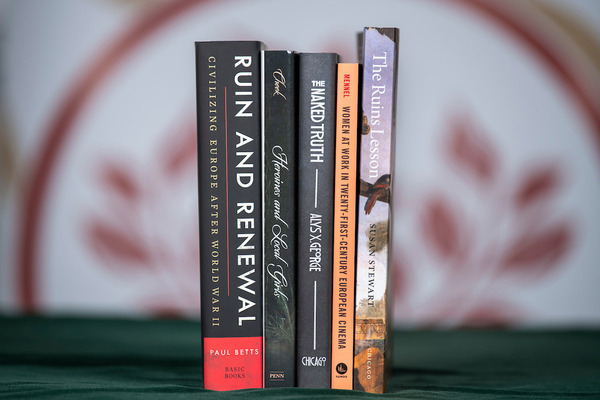
The Nanovic Institute for European Studies at the University of Notre Dame announces the 2022 shortlist for the Laura Shannon Prize in Contemporary European Studies. Carrying a prize of $10,000, the Laura Shannon Prize is recognized internationally as one of the leading book prizes in the field of European studies. Each year, the Nanovic Institute, which is part of the Keough School of Global Affairs, gives this award to the author of the best book in European studies that transcends a focus on any one country, state, or people to stimulate new ways of thinking about contemporary Europe as a whole.
The 2022 prize will be awarded to the best humanities book published in 2019 and 2020. The winning book, which will be announced in January 2022, will be selected by a jury of five eminent scholars in European studies, at least three of whom are faculty at institutions other than the University of Notre Dame.
The finalists for the 2022 Laura Shannon Prize are:
- “Ruin and Renewal: Civilizing Europe After World War II” by Paul Betts (Basic Books, Hachette Book Group);
- “Heroines and Local Girls: The Transnational Emergence of Women’s Writing in the Long Eighteenth Century” by Pamela Cheek (University of Pennsylvania Press);
- “The Naked Truth: Viennese Modernism and the Body” by Alys George (University of Chicago Press);
- “Women at Work in Twenty-First-Century European Cinema” by Barbara Mennel (University of Illinois Press);
- “The Ruins Lesson: Meaning and Material in Western Culture” by Susan Stewart (University of Chicago Press).
Peter Gatrell, author of “The Unsettling of Europe: How Migration Reshaped a Continent” (Basic Books) and 2021 Laura Shannon Prize winner in history and social sciences, will accept the 2021 prize with a lecture on February 8, 2022. The 2022 winner of the Laura Shannon Prize will also accept their prize with a lecture.
Nominations for the 2023 history and social sciences cycle (for books published in 2020 and 2021) are currently being accepted and are due by February 15, 2022. For more information on the nomination process, please visit the Nanovic website.
First awarded in 2010, the Laura Shannon Prize is made possible through a generous endowment from Mrs. Laura Shannon (1939-2021) and her husband Michael ’58. Mrs. Shannon became a member of the Nanovic Institute’s Advisory Board in 2003 and served for 18 years. As well as her work in social services and family court mediation, she was a regular visitor to Europe, particularly to France where she honed her language skills and explored libraries and cultural centers. Mr. Shannon is president of MEShannon & Associates, a Houston-based financial consulting firm.
Brief summaries of the five shortlisted titles, as found on their publishers’ websites, can be read below.

“Ruin and Renewal: Civilizing Europe After World War II” by Paul Betts (Basic Books, Hachette Book Group)
In 1945, Europe lay in ruins. Some fifty million people were dead, and millions more languished in physical and moral disarray. The devastation of World War II was unprecedented in character as well as in scale. Unlike the First World War, the second blurred the line between soldier and civilian, inflicting untold horrors on people from all walks of life. A continent that had previously considered itself the very measure of civilization for the world had turned into its barbaric opposite.
Reconstruction, then, was a matter of turning Europe’s “civilizing mission” inward. In this magisterial work, Oxford historian Paul Betts describes how this effort found expression in humanitarian relief work, the prosecution of war crimes against humanity, a resurgent Catholic Church, peace campaigns, expanded welfare policies, renewed global engagement and numerous efforts to salvage damaged cultural traditions. Authoritative and sweeping, Ruin and Renewal is essential reading for anyone hoping to understand how Europe was transformed after the destruction of World War II.
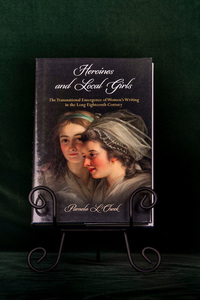
“Heroines and Local Girls: The Transnational Emergence of Women’s Writing in the Long Eighteenth Century” by Pamela Cheek (University of Pennsylvania Press)
Over the course of the long eighteenth century, a network of some fifty women writers, working in French, English, Dutch, and German, staked out a lasting position in the European literary field. These writers were multilingual and lived for many years outside of their countries of origin, translated and borrowed from each others’ works, attended literary circles and salons, and fashioned a transnational women’s literature characterized by highly recognizable codes.
Drawing on a literary geography of national types, women writers across Western Europe read, translated, wrote, and rewrote stories about exceptional young women, literary heroines who transcend the gendered destiny of their distinctive cultural and national contexts. These transcultural heroines struggle against the cultural constraints determining the sexualized fates of local girls.
In “Heroines and Local Girls,” Pamela L. Cheek explores the rise of women’s writing as a distinct, transnational category in Britain and Europe between 1650 and 1810. Starting with an account of a remarkable tea party that brought together Frances Burney, Sophie von La Roche, and Marie Elisabeth de La Fite in conversation about Stéphanie de Genlis, she excavates a complex community of European and British women authors. In chapters that incorporate history, network theory, and feminist literary history, she examines the century-and-a-half literary lineage connecting Madame de Maintenon to Mary Wollstonecraft, including Charlotte Lennox and Françoise de Graffigny and their radical responses to sexual violence. Neither simply a reaction to, nor collusion with, patriarchal and national literary forms but, rather, both, women’s writing offered an invitation to group membership through a literary project of self-transformation. In so doing, argues Cheek, women’s writing was the first modern literary category to capitalize transnationally on the virtue of identity, anticipating the global literary marketplace’s segmentation of affinity-based reading publics, and continuing to define women’s writing to this day.
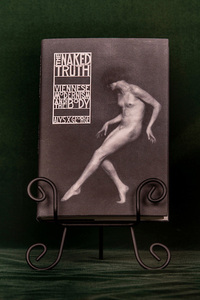
“The Naked Truth: Viennese Modernism and the Body” by Alys George (University of Chicago Press)
Viennese modernism is often described in terms of a fin-de-siècle fascination with the psyche. But this stereotype of the movement as essentially cerebral overlooks a rich cultural history of the body. “The Naked Truth,” an interdisciplinary tour de force, addresses this lacuna, fundamentally recasting the visual, literary, and performative cultures of Viennese modernism through an innovative focus on the corporeal.
Alys X. George explores the modernist focus on the flesh by turning our attention to the second Vienna medical school, which revolutionized the field of anatomy in the 1800s. As she traces the results of this materialist influence across a broad range of cultural forms—exhibitions, literature, portraiture, dance, film, and more—George brings into dialogue a diverse group of historical protagonists, from canonical figures such as Egon Schiele, Arthur Schnitzler, Joseph Roth, and Hugo von Hofmannsthal to long-overlooked ones, including author and doctor Marie Pappenheim, journalist Else Feldmann, and dancers Grete Wiesenthal, Gertrud Bodenwieser, and Hilde Holger. She deftly blends analyses of popular and “high” culture, laying to rest the notion that Viennese modernism was an exclusively male movement. “The Naked Truth” uncovers the complex interplay of the physical and the aesthetic that shaped modernism and offers a striking new interpretation of this fascinating moment in the history of the West.
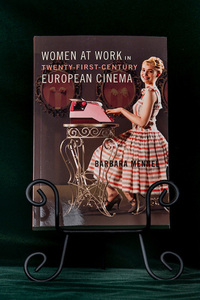
“Women at Work in Twenty-First-Century European Cinema” by Barbara Mennel (University of Illinois Press)
From hairdressers and caregivers to reproductive workers and power-suited executives, images of women’s labor have powered a fascinating new movement within twenty-first-century European cinema. Social realist dramas capture precarious working conditions. Comedies exaggerate the habits of the global managerial class. Stories from countries battered by the global financial crisis emphasize the patriarchal family, debt, and unemployment.
Barbara Mennel delves into the ways these films about female labor capture the tension between feminist advances and their appropriation by capitalism in a time of ongoing transformation. Looking at independent and genre films from a cross-section of European nations, Mennel sees a focus on economics and work adapted to the continent’s varied kinds of capitalism and influenced by concepts in second-wave feminism. More than ever, narratives of work put female characters front and center—and female directors behind the camera. Yet her analysis shows that each film remains a complex mix of progressive and retrogressive dynamics as it addresses the changing nature of work in Europe.
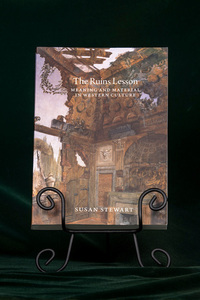
“The Ruins Lesson: Meaning and Material in Western Culture” by Susan Stewart (University of Chicago Press)
How have ruins become so valued in Western culture and so central to our art and literature? Covering a vast chronological and geographical range, from ancient Egyptian inscriptions to twentieth-century memorials, Susan Stewart seeks to answer this question as she traces the appeal of ruins and ruins images, and the lessons that writers and artists have drawn from their haunting forms.
Stewart takes us on a sweeping journey through founding legends of broken covenants and original sin, the Christian appropriation of the classical past, and images of decay in early modern allegory. Stewart looks in depth at the works of Goethe, Piranesi, Blake, and Wordsworth, each of whom found in ruins a means of reinventing his art. Lively and engaging, “The Ruins Lesson” ultimately asks what can resist ruination—and finds in the self-transforming, ever-fleeting practices of language and thought a clue to what might truly endure.